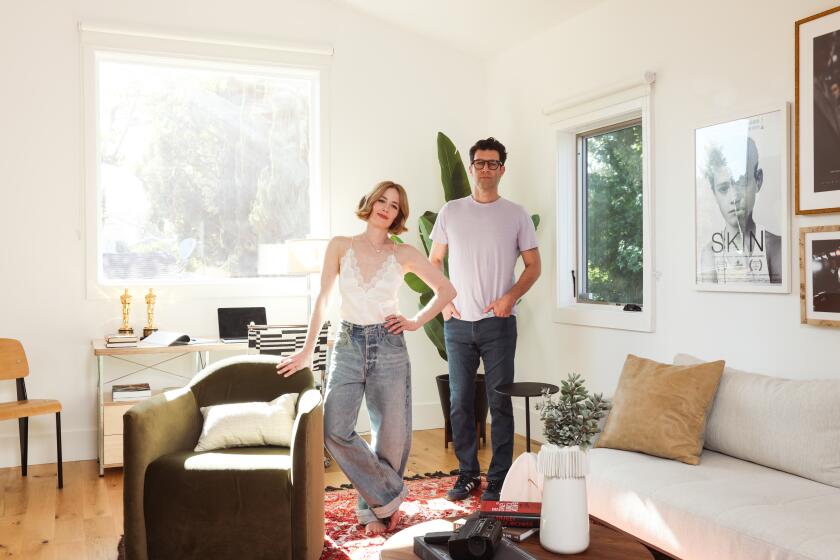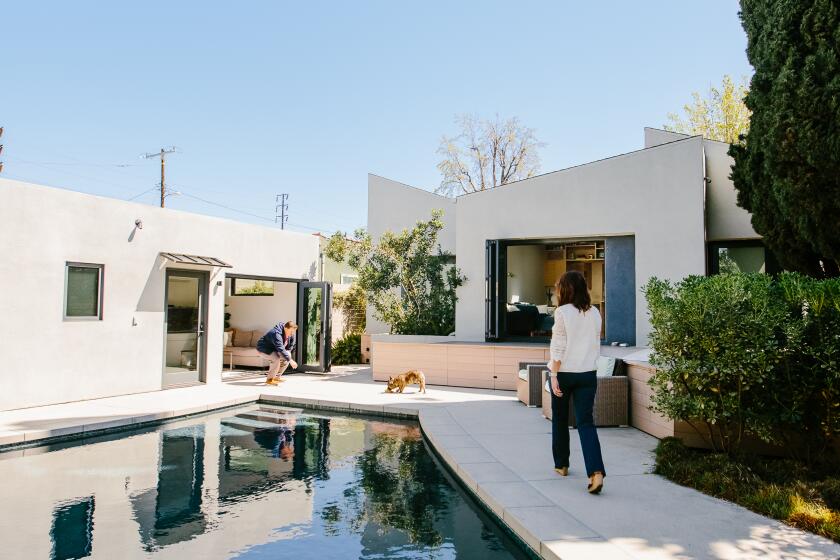‘Red Building’ Will Complete Pacific Design Center
They’re seeing red over the newest mega-construction project planned for West Hollywood. And they couldn’t be happier.
The red in this case is the glistening color proposed for a building that will complete the landmark Pacific Design Center, which for nearly three decades has been a showcase for fine furnishings -- and for bold, modern architecture.
The planned 400,000-square-foot red-glass building will join distinctive blue and green glass-sheathed structures on the center’s 14-acre site at Melrose Avenue and San Vicente Boulevard.
When finished, the Red Building, as it’s already being called, will complete architect Cesar Pelli’s vision of a king-size sculpture garden that forms the centerpiece of 1.9-square-mile West Hollywood.
Delighted city officials have approved a 7 1/2-year development permit so the center’s owner can build it. That’s more than three times the normal period given developers.
City leaders say they are happy that property owner Charles Cohen has decided to finish what Pelli started in the early 1970s.
“There was doubt for many years that it would ever be completed,” said Ray Reynolds, director of economic development for West Hollywood. “We wondered if Cesar Pelli’s vision would ever be complete.”
Pelli, an acclaimed Argentina-born architect whose work includes the world’s tallest structures, the 1,483-foot twin Petronas Towers of Kuala Lumpur, Malaysia, wondered if the Pacific Design Center would ever be finished, too.
In drawing the master plan for the site in the 1970s, Pelli called for bold colors and shapes that would turn conventional, boxy showrooms and furniture mart areas into sculptural objects.
His 750,000-square-foot Blue Building loomed over the low-rise Melrose Avenue neighborhood of boutiques and bungalows in 1975 when it opened as the first phase of what quickly became the West Coast’s largest home-furnishings center.
Because its interior-oriented showrooms didn’t need exterior windows, its walls of nontransparent blue glass and its six-story rounded top earned it the nickname the “Blue Whale.”
The Blue Building was an immediate hit with both manufacturers and buyers of high-end furnishings, and in 1988, the second-phase Green Building furnishings mart opened.
But that 450,000-square-foot, nine-story structure was caught in an economic slump that crimped the home-furnishings industry in the early 1990s. By 1998, the former owner of the Pacific Design Center had converted half of the Green Building into “creative” office space, adding windows to the structure.
Pelli, who has designed the Red Building as an office building for firms such as media and entertainment companies, helped with the Green Building’s window retrofit. He said he is pleased that the Design Center is finally going to be completed.
“Oh my God, I couldn’t be more excited. You always hope it will be finished, but you never know,” he said of the project.
The Red Building will be a wedge-shaped structure, divided in half by an atrium. Its two sides will have an almost pie-shaped footprint and will sit atop an eight-level parking structure.
“We’ve been adjusting it,” Pelli said of the office-use plan. “Circumstances have changed, of course, since we started. When we designed it, originally, it was to be for all showrooms. But the showroom market has almost vanished.”
Based in New Haven, Conn., Pelli, 77, said he and his staff will help oversee the construction.
“It will be very close to the original plan,” he said.
That 1970s proposal called for the Blue Building to be basically rectangular, the Green Building to have triangular touches and the Red Building to have a curved, semicircular look.
But Pelli said a simple square, triangle and circle was never really the theme.
“People can see it like that, but that’s not the plan. It was to be sculptural figures,” he said.
Cohen, the Design Center’s New York-based president, did not return phone calls seeking comment. But after the investment group he heads purchased the center in 1999 for $165 million, he acknowledged that its architecture was its selling point.
“It looked so spectacular,” he told The Times. “I saw this giant blue and green Lego set and it knocked me out. I knew I wanted it.”
Robert Kalonian, a consultant to Cohen, said the office-leasing market will determine when Red Building construction begins, although a start date is likely to be three to five years away.
The cost of the new building is estimated to be in the $100-million range.
In a report to the West Hollywood City Council, which approved the plan in November, city staff members called the current Pacific Design Center “a masterpiece of modern design.”
John Chase, urban designer for the city’s planning department, wrote an almost lyrical analysis of the center, explaining how the Red Building would include red-tinted office “vision windows” that will blend in with the opaque red ceramic glass walls.
“The Red Building has both important similarities and differences with the exciting Blue and Green buildings,” he wrote. “The Green and Blue buildings are large volumetric forms, with glassy reflective skins, each in a strong, basic color. The skin of these buildings is taut and depthless with all the elements in the same plane, without changes in depth, returns or reveals.
“The Red Building is asymmetric in design, while the Blue Building, and to a slightly lesser degree, the Green Building are symmetrical. The exception to this symmetry is the rotation of the central cube block of the Green Building above its base. While the Green Building and the Blue Building appear as stable, centered, closed and composed volumes, the Red Building is more dynamic. Its form is more aggressive.... “
Chase concluded that the completed Pacific Design Center would be “the single most monumental space accessible to the public in West Hollywood, a space that has the scale and size to be appropriate for the heart of a city located in a major metropolis.”
This week, Chase said the Design Center has managed to stay “fresh, sharp, crisp and powerful” for a more simple reason.
It remains “a beautiful, glossy, shiny object,” he said. “The world’s largest toy.”




